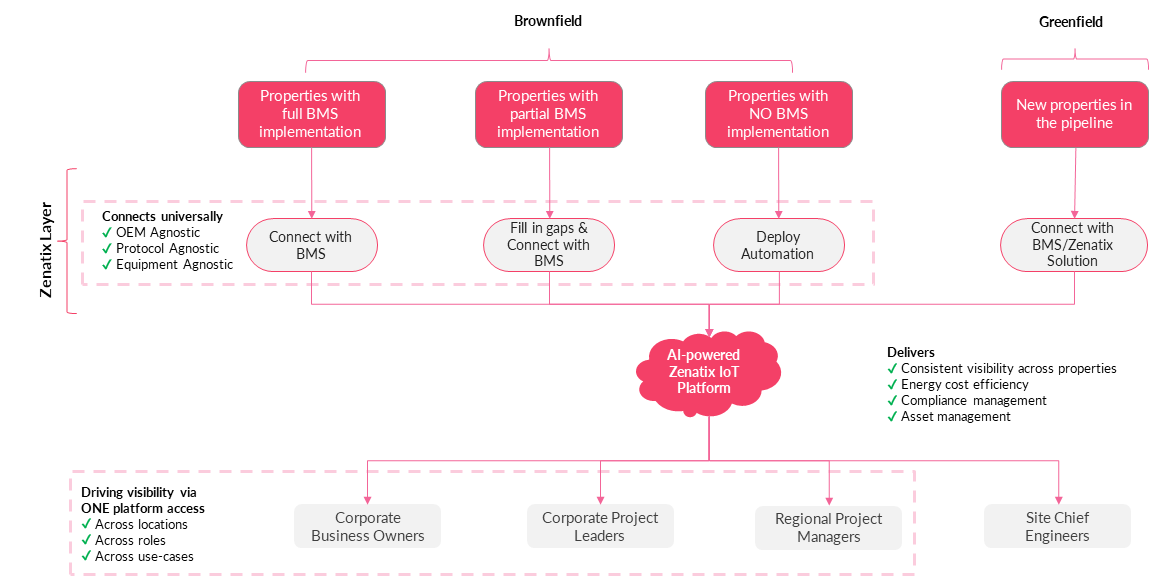Commercial building portfolios today comprise a mix of legacy buildings, newly constructed properties, and upcoming projects. These buildings fall into two broad categories: brownfield properties—existing structures requiring upgrades to meet modern standards—and greenfield properties, which are newly built and designed from the ground up.
Managing such a diverse portfolio poses unique challenges. Legacy buildings often operate with outdated infrastructure, while new projects demand future-ready solutions to ensure long-term efficiency. Growing businesses need a scalable, unified approach to managing these properties.
Table of Contents
ToggleTraditional Building Management Systems (BMS) and Their Challenges
Building Management Systems (BMS) have long been the solution for managing energy, HVAC, and other critical systems in commercial buildings. They are designed to streamline operations and improve efficiency. However, their deployment is often inconsistent across a portfolio. Businesses typically implement BMS in only a few buildings, leaving others unmanaged or reliant on manual processes.
An uneven deployment creates challenges like:
1. Lack of Centralization: Without a unified system, businesses struggle to get a holistic view of their portfolio’s performance. Data silos make it difficult to monitor and compare energy usage, system health, and other key metrics across multiple locations.
2. High Costs: Installing BMS in all properties can be expensive, especially for older buildings that require significant retrofitting.
3. Compatibility Issues: Legacy systems and equipment often lack the flexibility to integrate with modern BMS, leading to inefficiencies and operational bottlenecks.
4. Limited Scalability: Traditional BMS are not designed to adapt easily as businesses grow and add new buildings to their portfolio.
While BMS remains a valuable tool for individual buildings, its limitations highlight the need for a more adaptable and portfolio-wide solution to address the dynamic needs of modern businesses.
The Growing Portfolio: A Need for Scalable and Agile Solutions
As businesses expand, their building portfolios evolve, incorporating a mix of legacy sites, newly acquired properties, and upcoming projects. Organizations must decide whether to deploy a BMS at the new sites.
While BMS offers localized control, it often falls short when managing a growing portfolio. The lack of standardization across sites results in fragmented systems, making operational consistency difficult. The high costs and compatibility challenges associated with BMS make them less feasible for every property, especially smaller or older ones.
Modern IoT-based solutions have emerged as a superior alternative, offering businesses the flexibility and scalability they need. These solutions stand out because they are:
1. OEM Agnostic: Compatible with equipment from any manufacturer, removing dependency on specific brands.
2. Protocol Agnostic: Designed to work seamlessly across different communication protocols, ensuring smooth integration.
3. Equipment Agnostic: Capable of managing various systems, from HVAC to lighting and beyond, regardless of the equipment type or model.
IoT-based solutions empower businesses to overcome the limitations of traditional BMS, making it easier to manage and scale operations as their portfolios grow. With these capabilities, companies can future-proof their properties and ensure consistent performance across all sites.
IoT-powered Solutions: Flexibility Across Property Types
IoT-based solutions offer unparalleled adaptability, enabling businesses to manage different property types efficiently. These solutions cater to both brownfield and greenfield properties, addressing unique challenges and ensuring seamless integration across the portfolio.
1. Brownfield Properties
Properties with Full BMS Implementation: For sites already equipped with a BMS, IoT solutions integrate seamlessly to unify data and enhance visibility. They centralize operations by connecting the BMS to a larger platform, enabling portfolio-wide insights.
Properties with Partial BMS Implementation: In cases where BMS coverage is limited, IoT solutions fill the gaps. They connect isolated systems and integrate with the existing BMS to provide a cohesive management experience.
Properties with No BMS Implementation: For buildings without a BMS, IoT solutions enable end-to-end automation and monitoring from scratch. These solutions bring these properties online, delivering advanced capabilities without a traditional BMS infrastructure.
2. Greenfield Properties
Newly constructed properties offer the flexibility to adopt cutting-edge solutions from the outset. IoT-based systems can be deployed independently or alongside a BMS to create a hybrid approach. This ensures future-ready operations and enables consistent management practices across all new developments.
IoT-powered platforms provide the agility to address varying levels of technological capability in different properties. They unify operations across legacy buildings, partially automated sites, and new constructions, enabling businesses to manage their entire portfolio through a single, scalable system.
Benefits of an IoT-powered Solution for Portfolio-Wide Management
IoT-powered systems offer a transformative approach to managing commercial buildings. They integrate diverse properties onto a unified platform, delivering unmatched visibility, efficiency, and control. Some key benefits are:
1. Unified Visibility Across the Portfolio
Across Locations: Businesses can monitor all properties—legacy, new, and upcoming—on a single platform, eliminating data silos and enabling real-time insights across sites.
Across Roles: Customized dashboards provide role-specific views for corporate business owners, regional project managers, site engineers, and other stakeholders, ensuring everyone has access to the required information.
Across Use Cases: IoT platforms support multiple applications, including energy monitoring, predictive maintenance, compliance tracking, and asset management.
2. Enhanced Operational Efficiency
Consistent Visibility: IoT-based systems standardize monitoring and control across all properties, ensuring uniform management practices.
Energy Cost Efficiency: Businesses can reduce wastage and achieve measurable cost savings by automating energy-intensive systems like HVAC and lighting.
Compliance Management: IoT solutions simplify adherence to sustainability and regulatory requirements through automated data tracking and reporting.
3. Advanced Asset Management
Real-time monitoring of equipment health ensures early detection of anomalies and enables predictive maintenance. This reduces downtime, extends asset lifespan, and lowers repair costs.
IoT-based systems empower businesses to future-proof their operations by delivering centralized control, actionable insights, and cost-effective management.
Conclusion: Building a Connected, Future-Ready Portfolio
Adopting IoT-based platforms allows businesses to achieve consistent visibility across locations, roles, and use cases. These solutions provide the flexibility to integrate with existing systems, fill operational gaps, and enable end-to-end automation where needed.
As businesses look to future-proof their operations, IoT provides the tools to build smarter, more efficient, and sustainable portfolios, empowering organizations to thrive in a dynamic, competitive landscape.

